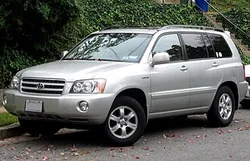

Toyota Highlander - Generation 2 U40 Overview
Explore the Toyota Highlander, focusing on the second generation U40 model. Discover its features, specifications, and performance in Portugal. Find your perfect match!
The Toyota Highlander is a mid-size crossover SUV that has been a popular choice for families since its introduction in 2000. The second generation, known internally as the U40, was produced from 2007 to 201...
Technical Specifications
Select Version
Dimensions
Engine
Driving
Others
History and Features
Mycarro AI
Apr 27, 2025
The Toyota Highlander is a mid-size crossover SUV that has been a popular choice for families since its introduction in 2000. The second generation, known internally as the U40, was produced from 2007 to 2013. This generation brought significant updates in design, features, and technology compared to its predecessor, making it a formidable entry in the competitive SUV market.
Design and Aesthetics
The second-generation Highlander sported a more refined and modern design, which represented a departure from the somewhat boxy appearance of the first generation. The U40 featured a sleeker profile, with a rounded nose, stylish headlights, and a sculpted body that improved aerodynamics. The rear of the vehicle was also redesigned with a more contemporary look, prominently featuring LED taillights. Toyota emphasized functionality in the Highlander’s design, offering options like a roof rack to enhance its utility as a family vehicle.
Interior Comfort and Features
Inside, the Highlander U40 was designed with a family-friendly focus and provided ample space for passengers and cargo alike. With a three-row seating arrangement, it could accommodate up to seven passengers comfortably, with roominess that would rival larger SUVs. The interior materials were upgraded significantly, providing a more upscale feel with options like leather seating and high-quality plastics. Toyota also made technology a priority, introducing features like Bluetooth connectivity, a premium JBL sound system, and a touchscreen infotainment system in higher trim levels, enhancing both convenience and entertainment for families on the go.
Performance and Powertrain
The U40 generation of the Highlander came equipped with two main powertrain options: a 2.7-liter four-cylinder engine and a more powerful 3.5-liter V6 engine. While the four-cylinder version offered decent fuel economy, the V6 was the preferred option for those seeking a blend of power and efficiency. The V6 engine produced 270 horsepower, providing ample acceleration and towing capacity, which made it suitable for families with active lifestyles. Moreover, the Highlander offered an optional all-wheel-drive system, giving drivers added confidence in diverse driving conditions.
Safety Features
In terms of safety, Toyota prioritized the Highlander U40 with numerous advanced features designed to protect occupants. The model received high safety ratings from organizations like the National Highway Traffic Safety Administration (NHTSA) and the Insurance Institute for Highway Safety (IIHS). Standard safety features included multiple airbags, stability and traction control, and antilock brakes. Higher trim levels offered additional technologies, such as rear parking sensors and a rearview camera, which were instrumental in aiding drivers during parking maneuvers.
Driving Experience
The driving experience in the U40 Highlander was characterized by a smooth and comfortable ride, which is largely due to its well-tuned suspension system. While it may not have been the most sport-oriented SUV on the market, the Highlander delivered a confident and stable performance on the road. Its steering was responsive, and drivers appreciated the vehicle's ability to handle various driving scenarios, from city commutes to longer highway trips. The relatively quiet cabin also contributed to an overall pleasant driving experience.
Market Reception and Legacy
The second-generation Highlander was well-received in the automotive marketplace, consistently ranking as one of the top mid-size SUVs in sales. It appealed particularly to families seeking reliability, safety, and comfort in a vehicle. The Highlander U40 solidified Toyota’s reputation for producing durable and dependable vehicles, and it paved the way for future generations of the model. Its success led Toyota to continue innovating and improving the Highlander, ensuring it remained competitive amid a constantly evolving automotive landscape.
In conclusion, the Toyota Highlander Generation 2 (U40) marked a significant step forward for the model, combining elegant design, comfortable interiors, robust performance, and a focus on safety. These attributes contributed to its lasting impact and popularity within the SUV segment, setting a benchmark for future generations to follow.
